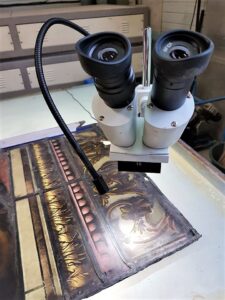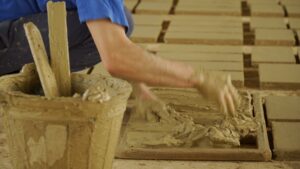
© Emma Isingrini-Groult: stained glass restoration in France. Mad’in Europe
A provocative title, but is it a wakeup call ahead of 2023 the European Year of Skills for the religious heritage sector to appreciate and use the skills of dedicated crafts people? These are skills honed over centuries, that have been used to build Europe’s wonderful corpus of religious buildings, but are in danger of being lost unless more is done to train future generations. Throughout previous centuries training and apprenticeships have been seen as important in maintaining skilled workforces and of master craftspeople passing on their skills and knowledge in individual workshops and as ‘journeymen’ passing skills on as they travelled.
In general, as a sector, very little appears to be said about the skills being used on tangible and intangible heritage in maintenance and conservation. When a building or artefact has been conserved is there always a public acknowledgement of the craftspeople involved, how they have worked on the building or artefact? To alert the general public to what is involved in this work – quite often over a period of years? This is important for several reasons, the first being an ageing workforce, which is not being adequately replaced with younger people, the second being small heritage craft businesses or single crafts people who struggle to find the finance to take on apprentices who could then take over their work in the future. Thirdly there are not enough training places in vocational training institutions that cater for the specific craft needs to be used in the heritage sector.
© Lola Perez Fernandez, tile maker from Spain. Mad’in Europe © Lola Perez Fernandez, tile maker from Spain. Mad’in Europe
Additionally, there are the issues of climate change and sustainability. Old buildings are very important as part of the climate change agenda. Maintaining and conserving them is far better for the climate than demolishing them and replacing them with new buildings. Re-purposing religious buildings for example could add to preventing the increasing depopulation of rural areas especially in Southern Europe.
What is to be done to ensure that in future years there are enough skilled heritage crafts people to undertake all the work required on both religious buildings and intangible artefacts in our sector as well as in the secular sector?
The data must exist across Europe, that gives a view of the possible number of religious buildings under threat of loss or demolition in both urban and rural settings –the most important is the data on rural areas. With this information mapped, it should be possible to start looking at the number of crafts people existing around the area of the buildings in the most important craft skills – stone masonry, wood working, plaster and lime, glass, wall paintings and frescoes. This information could be the start of building up an FRH Register of crafts people. There would need to be criteria for joining the register to ensure people have the requisite craft qualifications, health and safety and GDPR certificates and so on. The register would be one that can be used by people looking to use crafts people on maintenance and conservation. Another aspect of this could be the establishment of both maintenance and conservation guides at local and regional level so that there are base lines from which to proceed on both religious and secular buildings.

Research is needed into training institutions, to see where they are based, and the courses offered; are they theoretical only or a mixture of practical as well as theoretical? Practical ‘on the job’ training is essential. Students can be learning as well as putting their training into practice by helping to conserve the building where they might be learning. Religious buildings would be ideal training places, particularly in rural areas. With the possible closure of many churches, re-use as training hubs might help to encourage an understanding of the great importance of religious heritage in the making of European history. There is much ignorance amongst the general public of the part that religious buildings have played as ‘building blocks’ in the history of Europe. These buildings were and still should be community spaces for the use of local people and encouraged to be so.
What qualifications students graduate with, what openings there are post- graduation for apprenticeships, for setting up their own businesses are also important considerations if crafts are to be built up, again especially in rural areas where links to tourism should not be underestimated and indeed should be encouraged.
© Emma Isingrini-Groult: stained glass restoration in France
Mad’in Europe
Another important consideration is that Heritage craft skills cut across all religions and make for a diverse European workforce. Finding and encouraging migrants with such skills to work in the sector should be one of the goals in religious heritage. There is always such a great deal to be learnt from cross-cultural working.
In the European Year of Skills, the religious heritage sector needs to establish heritage crafts skills training as an important part of skills to be learnt. Alongside digital skills and business skills training, young people can be encouraged to consider crafts as a wonderful opportunity for learning and doing. There is never a shortage of work to be done, and it is also essential that skills are not allowed to die out.
Jennie Hawks
Building Crafts and Conservation Foundation.







Follow us: